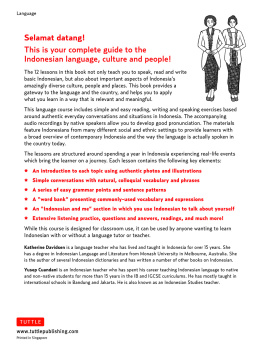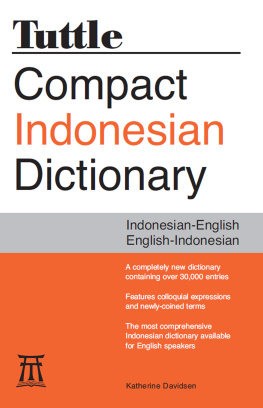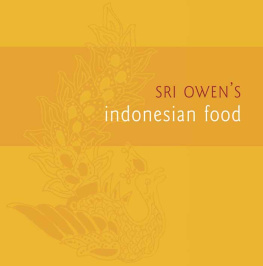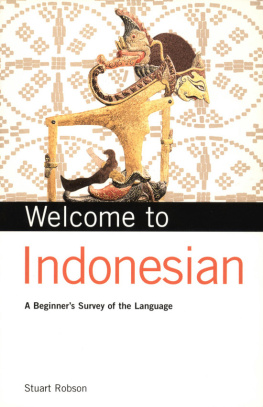Acknowledgements I would like to thank my brother Eric, who originally suggested that I write this book, made many valuable suggestions, and edited the final manuscript. I would also like to thank my parents, Tom and Berenice; my aunt and uncle in Java, Tante Inggawati and Om Sutantho; the employees of Java Books and Java Engineering, who read portions of the draft and suggested many improvements; and Sudarno Sumarto, who read the draft in its final stages.
APPENDIX A Verb and Noun Affixes Indonesian has many words that are derived from simple roots through the addition of prefixes and suffixes. For example, the word baik alone means good and serves as the root for kebaikan (with prefix ke- and suffix -an ) meaning goodness. Memperbaiki (using the memper - prefix and -i object suffix) means to improve (something), while the noun perbaikan ( per- and -an ) means improvement or correction. When dealing with derived forms, you need to know the mechanical rules for adding prefixes and suffixes to root words.
Then you are able to identify roots of words you come across so you can look them up in a dictionary. Second, you need to understand how the addition of these various prefixes and suffixes changes the meaning of a root. Not every affix can be used for every root. As with any language, you need to learn the vocabulary, but understanding the affix system helps learners of Indonesian greatly. You will find that it is quite logical, and that you will be able to guess the meanings of many new words.
Verb Affixes The active prefix meN- (for transitive verbs) Most transitive verbs (verbs which can take a direct object) may be prefixed by meN- (where N stands for various letters, depending on the first letter of the root word that follows). that the subject of the verb is the main focus or topic of the sentence. lihat melihat to see Saya sudah melihat Borobudur. lihat melihat to see Saya sudah melihat Borobudur.
I have already seen Borobudur.
In some cases, the addition of meN- dramatically alters the meaning of the root word, as in the example of tinggal (stay; leave) meninggal (die, pass away), where the latter is a shortened form of meninggal dunia meaning to depart the world.
As already mentioned in Part Two: , in colloquial speech the prefix is usually omitted. Note also that this prefix is rarely used in imperatives.
This active verb prefix is also used to create verbs out of nouns and adjectives. In this case the root and the prefixed form have quite different, although related, meanings.
kuning yellow menguning to turn yellow kipas a fan mengipasi to fan
kunci a key mengunci to lock meN- forms The prefix meN- takes five different forms, depending on the first letter of the word that it is prefixed to. You will need to memorize the following rules for this.
1) meny- for words beginning with ssiram menyiram to spray, shower surat a letter menyurat to write a letter
2) mem- before words beginning with b- and p- beli membeli to buy pakai memakai to use
NB. This last form changes the initial - p of the base word to a - m . 3) men- for words beginning with d- , j- , c- and t dorong mendorong to push jual menjual to sell cuci mencuci to wash tonton menonton to watch (a movie, show)
NB.
This last form changes the initial - t of the base word to a - n .
4) meng- for words beginning with k , g , h or any vowel kirim mengirim to send
NB. This last form removes the initial -k of the base word.
ganggu mengganggu to disturb harap mengharapkan to hope atur mengatur to arrange
5) me- before all other initial consonants lukis melukis to paint mula memulai to begin nikah menikah to marry rusak merusak to damage warna mewarnai to color (in)
The active prefix ber- (for intransitive verbs) The active prefix ber- is used with intransitive verbs (those which cannot take a direct object) in much the same way that me- is prefixed to transitive verbs. As with the meN- prefix, it is often omitted in everyday speech. asal berasal to originate bicara berbicara to speak diri berdiri to stand kunjung berkunjung to pay a visit Saya ingin berkunjung ke rumah anda. I wish to pay a visit to your house.
Kami berasal dari Australia. We are from Australia.
 Note: That there are a number of irregular forms.
Note: That there are a number of irregular forms.
ajar teach belajar to learn kerja bekerja to work
When prefixed to a noun, ber- creates an active, intransitive verb that has the meaning possessing or taking the attribute of that noun or adjective.
kembang blossom, flower berkembang to develop, blossom, expand bahasa language berbahasa to know or speak a language pakaian clothing berpakaian to get dressed, be dressed kata words berkata to speak Koran ini tidak berbahasa Indonesia.
This newspaper is not in Indonesian.
 Note: Before words beginning with r , ber- becomes be- (which is to say that only one r appears in the resulting prefixed form).
Note: Before words beginning with r , ber- becomes be- (which is to say that only one r appears in the resulting prefixed form).
renang berenang to swim rencana berencana to plan The passive prefix di- The opposite of the active prefix meN- is the passive prefix di- which indicates that the object of the verb is the main focus or topic of the sentence. This is very similar to the passive voice in English. (See Part Two: for more examples with di- . )
Mobilnya belum diperbaiki. The car has not yet been repaired . Kita diundang ke psta.
We have been invited to a party. Nasinya sudah dimasak. The rice has already been cooked . The perfective prefix ter- The prefix ter- is used to indicate that an action has already been completed, with the emphasis being on the resultant state or condition of the direct object. As with di- the focus or main topic of the sentence is always the object of the verb and not the subject. In fact the subject is often not even mentioned when ter- is used, as it is either understood, unimportant or intentionally left ambiguous.
kenal know, be acquainted terkenal to be famous, well-known
atur arrange teratur to be well-organized, neat pakai use terpakai to have been used
This prefix is often used together with the word sudah meaning already.
Kamarnya sudah terkunci.
The room is already locked. Bon kami sudah terbayar belum? Has our bill been paid yet?
 Note: The use of ter- as a verb prefix is distinct from the use of ter- with adjectives, in which case it forms a superlative meaning the most, the greatest, etc. (See Part Two: .) The affix meN-kan The verb affix meN-kan creates transitive verbs out of intransitive verbs as well as nouns and adjectives.
Note: The use of ter- as a verb prefix is distinct from the use of ter- with adjectives, in which case it forms a superlative meaning the most, the greatest, etc. (See Part Two: .) The affix meN-kan The verb affix meN-kan creates transitive verbs out of intransitive verbs as well as nouns and adjectives.
selesai finished menyelesaikan to finish or settle something tinggal stay, leave meninggalkan to leave something behind kata words mengatakan to speak, say pasar market memasarkan to market (goods, etc.) betul correct membetulkan to correct
When -kan is added to a verb that is already transitive, it may indicate that the action is being focused on the direct object of the verb. -kan can also be used in the sense of a request.
Tolong bukakan pintu. Please open the door (for me).
Suffixed forms with -kan may be used in an active sense with me- (although the latter is often dropped in everyday speech), or in a passive sense with di- .
Saya belum menyelesaikan pekerjaan itu. I havent finished that work yet.
Kamra ini bisa diperbaiki tidak? Can this camera be fixed or not? The dative suffix -i The dative suffix -i is added to intransitive verbs and adjectives to create transitive verbs which imply that something is being done to, toward, for the benefit of, or by the subject.
















 Note: That there are a number of irregular forms.
Note: That there are a number of irregular forms.